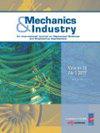Effect of bipropellant combustion products on the rocket nozzle design
IF 1.2
4区 工程技术
Q3 ENGINEERING, MECHANICAL
引用次数: 2
Abstract
The focus of this research work is to investigate numerically the effect of adding the gas on the design and performance of axisymmetric MLN nozzles. A FORTRAN code was developed to design this nozzle using the characteristics method (MOC) at high temperature. The thermochemical and combustion studies of the most used liquid propellants on the satellites and launch vehicles allow to known all gases. Four engines are investigated: Ariane 5 (Vulcain 2), Ariane-5 upper stage engine (Aestus), Zenit first stage (RD-170) and Falcon 9 upper stage (Raptor). Thermodynamic analysis of parameters design MLN (such as length, Mach number, mass, thrust coefficient) was conducted. The comparison shows that the presence of 50% of H2O gas in combustion species increases the nozzle design parameters (diatomic gas including air) in the order of 25%. On the other hand, the existence of CO2 gas considerably increases approximately 35% the length and the exhaust radius. These rise depend on gases percentage in the combustion. The truncation method is applied in the MLN nozzles to optimize the thrust/weight ratio.二元推进剂燃烧产物对火箭喷管设计的影响
本文的研究重点是对轴对称MLN喷嘴加气对设计和性能的影响进行数值研究。利用高温特性法(MOC),编写了FORTRAN程序进行喷管的设计。对卫星和运载火箭上最常用的液体推进剂进行热化学和燃烧研究,可以了解所有气体。四种发动机被研究:阿丽亚娜5 (Vulcain 2),阿丽亚娜5上层发动机(Aestus), Zenit一级(RD-170)和猎鹰9上层(猛禽)。对设计参数MLN(如长度、马赫数、质量、推力系数)进行了热力学分析。结果表明,当燃烧组分中H2O气体的含量达到50%时,喷嘴的设计参数(含空气的双原子气体)提高了25%左右。另一方面,二氧化碳气体的存在大大增加了大约35%的长度和排气半径。这些上升取决于燃烧中气体的百分比。将截断法应用于MLN喷管,优化了推力/重量比。
本文章由计算机程序翻译,如有差异,请以英文原文为准。
求助全文
约1分钟内获得全文
求助全文
来源期刊

Mechanics & Industry
ENGINEERING, MECHANICAL-MECHANICS
CiteScore
2.80
自引率
0.00%
发文量
25
审稿时长
>12 weeks
期刊介绍:
An International Journal on Mechanical Sciences and Engineering Applications
With papers from industry, Research and Development departments and academic institutions, this journal acts as an interface between research and industry, coordinating and disseminating scientific and technical mechanical research in relation to industrial activities.
Targeted readers are technicians, engineers, executives, researchers, and teachers who are working in industrial companies as managers or in Research and Development departments, technical centres, laboratories, universities, technical and engineering schools. The journal is an AFM (Association Française de Mécanique) publication.
 求助内容:
求助内容: 应助结果提醒方式:
应助结果提醒方式:


